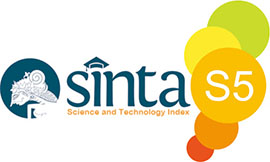ENGEMBANGAN MULTIMEDIA PRAKTIKUM BERBASIS LABORATORIUM VIRTUAL (VIRTUAL LABORATORY/Vi-Lab) PADA MATERI PERKULIAHAN KOMPUTER DI JURUSAN KTP FIP UNP
 ), Septriyan Anugrah(2),
), Septriyan Anugrah(2), (1) Universitas Negeri Padang
(2) Universitas Negeri Padang
 Corresponding Author
Corresponding Author
DOI : https://doi.org/10.24036/et.v8i1.109081
Full Text:
 Language : en
Language : en
 Language : en
Language : en
Abstract
In general, students consider that computer material is rather difficult and practicum requires special skills especially if there is no guidance and tutorial from the lecturers directly especially in the current co-19 pandemic, as a result not a few students who are less even less interested in understanding and mastering some theory and basic practice on the material. Therefore, lecturers must have the ability or skills to develop a multimedia practicum and use it in lectures so that learning objectives can be achieved. For example, multimedia practicum based on a Virtual Computer Laboratory (ViLab) that was developed can be used as a support in the learning process and practicum in the computer laboratory of the FIP UNP KTP Department, especially those taking computer practicum courses. This research development uses the Research and Development (R&D) method. Models and procedures developed using the ADDIE model with stages, including: analysis, design, development, implementation and evaluation. Based on the results of the development, the results obtained at the same time conclusions that the multimedia Laboratory-based Virtual Laboratory (Vi-Lab) is feasible to be used in learning as a media supporting the practicum This can be seen from the validation percentage of media experts and material experts, namely an average of 94.5% with a very good/very valid product category. Furthermore, it was tested on students (respondents) to find out the practicality level of media use by 88.5% with a very good/very practical category.
Keywords: Multimedia Practicum, Virtual Laboratory (Virtual Laboratory/Vi-Lab), Computer Practicum Lectures.
References
Barbour, M. K. & Reeves, T. C. (2009). The reality of virtual schools: A review of the literature. Computers and Education, 52, 402-416.
Harms, V. 2000. The virtual lab of instrumental methods of chemical analysis theory and exercise. Diambil 22 April 2013, dari: http://www.ntua.gr/virtlab/virtlab_eng.
Harry, E. & Edward, B. (2005). Making real virtual lab. The Science Education Review.
Imron, M. 2012. Diakses tanggal 28 Februari 2013. Ayo manfaatkan laboratorium komputeratorium Virtual. http://mazdosen.net.tc/ .
Mahmoud, A. & Zoltan, K. (2009). The impact of the virtual laboratory on the hands-on laboratory learning outcomes, a two years empirical study. 20th Australasian Association for Engineering Education Conference. University of Adelaide, 6-9 December, 2009.
Punaji Setyosari. 2010. Metode Penelitian Pendidikan dan Pengembangan. Jakarta: Kencana Pranada Media Grup.
Riduwan. 2010. Skala Pengukuran Variabel-variabel Penelitian. Bandung: Alfabeta.
Sugiyono. 2011. Metode Penelitian Kuntitatif, Kualitatif dan R&D. Alfabeta: Bandung.
 Article Metrics
Article Metrics
 Abstract Views : 241 times
Abstract Views : 241 times
 PDF Downloaded : 51 times
PDF Downloaded : 51 times
 PDF Downloaded : 6 times
PDF Downloaded : 6 times
Refbacks
- There are currently no refbacks.





